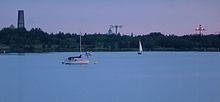Neuseenland
Appearance




Neuseenland is an area south of Leipzig, Germany, where old open-cast mines are being converted into a huge lake district. The region's name is a marketing concept and it means "New Lakeland" in German. It should not be confused with the German name for New Zealand, "Neuseeland". It is planned to be finished in 2060[1]
It contains the following lakes, some of which are not yet flooded:
| Name | Size |
|---|---|
| Lake Bockwitz | 170 hectares (420 acres) |
| Markkleeberg Lake | 252 hectares (620 acres) |
| Cospuden Lake | 436 hectares (1,080 acres) |
| Schladitz Lake | 220 hectares (540 acres) |
| Hain Lake | 387 hectares (960 acres) |
| Borna Reservoir | 265 hectares (650 acres) |
| Harth lake | 65 hectares (160 acres) |
| Witznitz Reservoir | 236 hectares (580 acres) |
| Haselbach Lake | 335 hectares (830 acres) |
| Störmthal Lake | 730 hectares (1,800 acres) |
| Haubitz Lake | 160 hectares (400 acres) |
| Werben Lake | 80 hectares (200 acres) |
| Kahnsdorf Lake | 112 hectares (280 acres) |
| Zwenkau Lake | 914 hectares (2,260 acres) |
| Kulkwitz Lake | 170 hectares (420 acres) |
| Peres Lake | 699 hectares (1,730 acres) |
| Lake Groitzsch | 840 hectares (2,100 acres) |
| Goitzsche Lake* | 1,353 hectares (3,340 acres) |
- 3 former open-cast mines north of Leipzig.
Altogether they have an expanse of 30,000 ha, approx 116 mi².
Once fully flooded they will have a final expanse of 270 mi² (70,000 ha)
References
Notes
External links
Wikimedia Commons has media related to Leipziger Neuseenland.
